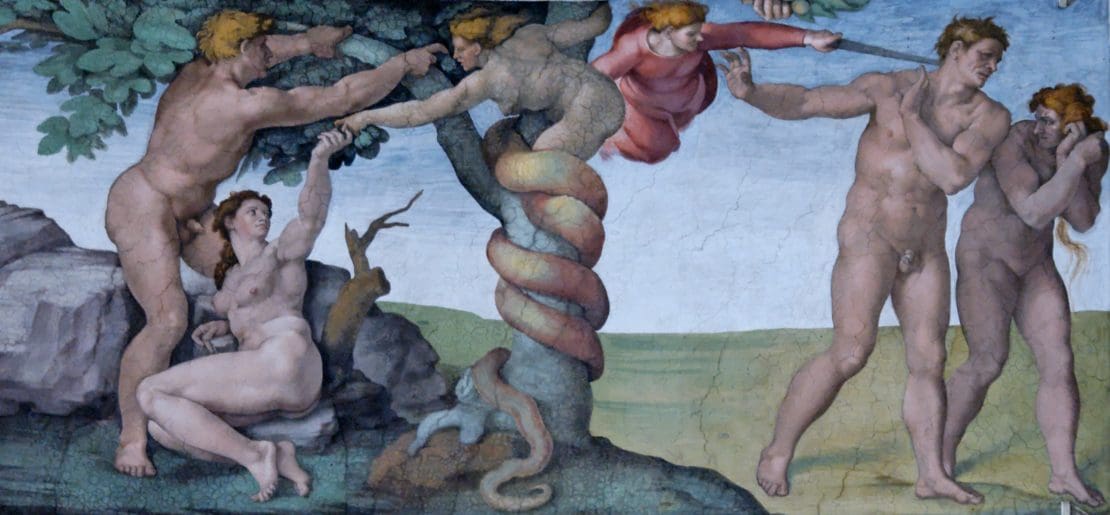“In the Beginning”
Having already outlined Pope St. John Paul’s thought on the human person and love as it is found in Love and Responsibility, the fifth through twelfth articles in our series are devoted to a second text, Man and Woman He Created Them, now known as the Theology of the Body, and promulgated to the faithful as Holy Father. To read the preceding article please click here.
The words of Christ stand at the centre of the reflections contained in Man and Woman He Created Them. As a whole the work is a meditation on the special kind of human love that can be formed upon the basis of sexual difference, precisely inasmuch as it finds its source in the love of the Creator and Redeemer and matures as a reflection of that very same love—thus becoming a theology of the body. The theology of the body opens with a reflection upon the words of Christ as found in St. Matthew’s Gospel:
Have you not read that from the beginning the Creator created them male and female and said, ‘For this reason a man will leave his father and mother and unite with his wife, and the two will be one flesh’? (Mt. 19:4-5)
In teaching about marriage Jesus guides his listeners to turn their attention to ‘the beginning,’ to creation and to the creative intention of God. Attending closely to these words of Christ, St. John Paul returns to the beginning and rereads Genesis in light of Christ’s guiding directive. Through a careful and detailed meditation upon the original state of our first parents, St. John Paul unearths perennial truths about the human person, human embodiment, and human sexuality—truths applicable to all human persons in all times and all places.
Previous to St. John Paul, Christian tradition had already identified the original state of the human person before original sin as a state of original justice and innocence. Original justice and innocence were a fruit of the life of grace bestowed upon our first parents from the first moment of their creation. The human person was originally created in direct and immediate relationship to God through a personal friendship with God established by a graced ‘participation in the inner life of God.’ As a result of this state of grace the human person was wholly and harmoniously ordered to God, with the direct consequence that he was also wholly and harmoniously ordered within himself. There was an original integrity and harmony in the very being of the human person, a further harmony in human interpersonal relationships, and a harmony between the human being and all of creation, all in consequence of the human creatures’ harmonious order to God his Creator. This was paradise.
St. John Paul expands upon this traditional teaching to manifest a further depth of understanding of the embodied human person in his native purity, thereby disclosing that implicitly contained in the state of original justice and innocence are found three further original states, states he calls ‘original solitude,’ ‘original unity,’ and ‘original nakedness.’ These original states, though now greatly obscured in consequence of the fall, nonetheless remain foundational to human experience in all subsequent generations. To explore their import for human life, it is necessary to revisit Genesis for the ‘keys’ to unlock the depth of human experience. Since Genesis charts the experience of our first parents as awareness of these original states is unfolded for consciousness, we too have to travel the same path to initially discover, and become ever more acutely aware of the proper expanse of human experience.
Man in Search of His Essence
As a personal being, the human being stands in creation conscious of his being and the rest of the created world. St. John Paul says, ‘The created man finds himself from the first moment of his existence before God in search of his own being.’ In the beginning, the first man experiences an original solitude as a result of being the only personal being in the visible created sphere. This original solitude has two interrelated dimensions, the first positive, the second negative: first, man is alone in the visible created sphere as a personal kind of being amongst subpersonal kinds of beings; then, man is alone without another personal individual with whom to live in a personal relationship. The first dimension of original solitude is brought home to the first man through his cultivation of the garden, his naming of the animals, and his entry into a covenant with God regarding the tree of knowledge of good and evil. In cultivating the garden and naming the animals, the first man recognises his distinction from the things he cultivates and names, and concomitantly realises that he is superior to those things. He stands in creation as one who understands things and determines them, and his understanding and determination signals his superiority to the other creatures amongst which he lives. Then, through his converse and covenant with God regarding the three of knowledge, he experiences himself as one who determines the course of his becoming and life.
In this way, through the progression of experience and, importantly, as guided by the Creator’s fatherly mediation, the first man realises that he is a personal kind of being amongst sub-personal beings. He experiences himself as being created in the image and likeness of God as rational and free, conscious and self-determining. He is a someone, not merely a something. Concomitant to this experience of the nature of his being, the first man realises ‘through his own humanity, through what he is, that he is so constituted as to be in a unique, exclusive, and unrepeatable relationship with God himself.’ As a personal being amongst a manifold of subpersonal beings the first man stands solitary in creation in singular relation to God—he dialogues personally with God. However, and importantly, all of this truth is brought home to the first man not in intellectual and spiritual abstraction, but in and through his bodily experience, precisely as bodily cultivating the garden, as naming the animals that are brought before him bodily, and as forbidden one kind of fruit as nourishment of the body. Original solitude brings before man’s consciousness that he is created in the image and likeness of God as an embodied person; and, at the same time, that though he is a ‘body among bodies’ he is not reducible to the material body, but is a special kind of bodily being, an embodied person.
Evidently then, this original solitude is not synonymous with loneliness as a negative emotional state, but actually contains an abundance of positive meaning, all of the positivity that comes with being created like the personal God, and in personal relationship with the personal God. However, according to the second dimension of original solitude, the first man has a negative experience: he is alone without another embodied personal being like himself. Consequently, God says, ‘It is not good that the man should be alone’ (Gen. 2:18). It is yet before the first woman has been created and the man experiences himself alone without another human person in the visible created sphere. Since there is nobody like himself there is nobody with whom to have a personal relationship of knowledge and love, a relationship adequate to his personal embodied nature as a conscious, free, and self-determining bodily being. As such, the first man becomes aware that his life is radically incomplete. On the horizontal plane of creation he cannot fulfill the meaning of his being—he is in need of a ‘help similar to himself’ (Gen. 2:18).
In this way, original solitude prepares the suitable ground and ‘opens the interior space’ for the possibility of the realisation of an original unity. When the first man beholds the first woman he exclaims, ‘This time she is flesh from my flesh and bone from my bones’ (Gn. 2:23). We hear in this exclamation of Adam a cry of primordial happiness. The first man beholds the first woman in her bodily presence—a bodily presence that signals a spiritual and personal being—and he rejoices in her being. And thus, an original unity is formed: ‘For this reason a man will leave his father and his mother and unite with his wife, and the two will be one flesh’ (Gen. 2:24). Adam and Eve unite to form an intimate personal relationship based upon their unity in duality, two human persons becoming ‘one flesh’ through their sexual duality. This intimate personal friendship formed by the first man and woman reveals a ‘reciprocal enrichment’ of the communion of persons found arising precisely out of their embodied sexual differentiation. It is not just two embodied persons able to communicate and share a common life together; no, it is a male-person and a female-person who can become ‘one flesh.’ Only through such an original unity could the first man realise the full meaning of his being created in the image and likeness of God and thereby attain to the completion of his being as a personal being.
‘Now both were naked, the man and his wife, but they did not feel shame’ (Gn. 2:25). The absence of shame in our first parents reveals a depth of purity arising from their creation in the state of innocence, a state St. John Paul calls original nakedness. Their nakedness without shame reveals that in the beginning the sexually determined human body readily revealed the person. With a bodily gaze not yet distorted and constrained by lust—based as it is upon the sexual objectification of the personal subject—the visible material body revealed the spiritual interior of the human person and did so with a radiant simplicity. The compelling beauty of the body and sexuality did not yet eclipse the captivating beauty of the person. The human body was experienced as the perfect manifestation of the personal spirit, with the native potential for the realisation of a deep personal love. Our first parents beheld each other with all ‘the peace of an interior gaze,’ a gaze of personal love that created the possibility of a fullness of personal intimacy. Indeed, their very nakedness revealed the original good of God’s creative vision: ‘behold, it is very good’ (Gen. 1:31). It signified a ‘simplicity and fullness of vision’ through which the pure value of the human person as male and female was readily manifest—and with it the pure value of the body and sexuality.
Awareness of these original states lays the appropriate foundation for understanding the most fundamental concept of the theology of the body, the spousal meaning of the body—to this we turn next.
__________________
Notes: See John Paul II, Man and Woman He Created Them: A Theology of the Body, trans. by M. Waldstein (Boston: Pauline, 2006), §§. 5:1-13:1, 16:3, esp. 5:5, 6:2-3, 9:2-5, 13:1, cp. 48:3, 132:3l; and Karol Wojtyła, Love and Responsibility, trans. by G. Ignatik (Boston: Pauline, 2013).


